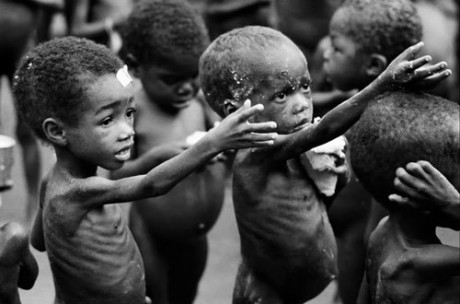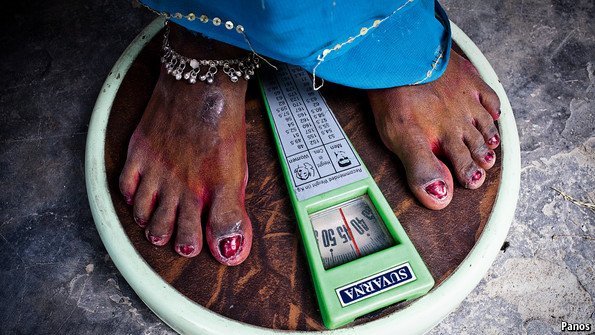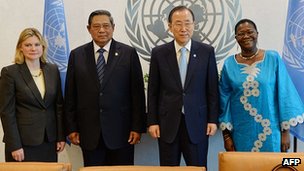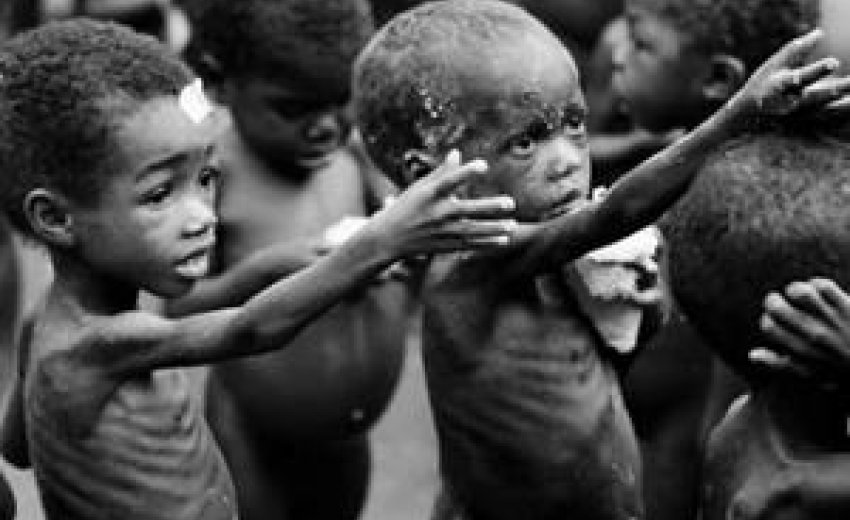A high-level U.N. panel recommended an ambitious roadmap to tackle the world’s major challenges, from climate change to equality for women, with a key goal of ending extreme poverty everywhere by 2030.
 U.N. Secretary-General Ban Ki-moon appointed the panel last year to recommend a new development agenda after the U.N. Millennium Development Goals, or MDGs, expire in 2015. World leaders agreed in 2000 on anti-poverty goals including cutting extreme poverty by half, halting the HIV/AIDS pandemic and increasing the number of people with access to clean water and sanitation.
U.N. Secretary-General Ban Ki-moon appointed the panel last year to recommend a new development agenda after the U.N. Millennium Development Goals, or MDGs, expire in 2015. World leaders agreed in 2000 on anti-poverty goals including cutting extreme poverty by half, halting the HIV/AIDS pandemic and increasing the number of people with access to clean water and sanitation.
The extreme poverty and clean water goals have been met, but many other of the goals probably won’t be achieved.
The 27-member U.N. panel expressed “deep respect” for the MDGs, saying: “The 13 years since the millennium have seen the fastest reduction in poverty in human history: there are half a billion fewer people living below an international poverty line of $1.25 a day. Child death rates have fallen by more than 30 percent, with about three million children’s lives saved each year compared to 2000. Deaths from malaria have fallen by one quarter.”
The panel proposed a major expansion of the MDGs — with a special focus on the more than one billion people still living on less than $1.25 a day — to tackle the causes of poverty such as weak government institutions, corruption, a lack of basic freedoms, conflict and hunger.
The panel’s report will kick-start two years of discussions and negotiations on what the development agenda after 2015 should be
The co-chairs, Indonesian President Susilo Bambang Yudhoyono, Liberian President Ellen Johnson Sirleaf and British Prime Minister David Cameron, called it a “bold and practical” proposal with 12 goals and 54 targets.
“Our vision and our responsibility are to end extreme poverty in all its forms in the context of sustainable development and to have in place the building blocks of sustained prosperity for all,” the panel said.
The recommended goals include ensuring food security, sustainable energy and sustainable natural resources management; creating jobs and promoting economic growth and good governance; achieving gender equality and ensuring stable and peaceful societies. Targets include promoting free speech and the rule of law, ending child marriage, protecting property rights, encouraging entrepreneurship and ensuring that every child has at least a primary school education.
Mexico’s former foreign relations secretary Patricia Espinoza, a panel member, said the vision for 2030 won’t be achieved “if the world continues to do business like we have been doing for the last decades.”
U.S. panelist John Podesta, who served as President Bill Clinton’s chief of staff and co-chaired President Barack Obama’s transition team, told a press conference that one of the MDGs’ failings was that it didn’t include proposals to promote the peace and security that world leaders talked about in 2000.
The panel rectifies this by recommending “building blocks” to peace and stability, but Podesta said “more than 40 percent of the extreme poor now live in conflict and conflict-affected states, so until we tackle that problem with real vigor, I think ... it’s hard to finish the job.”
Copyright 2013 The Associated Press. All rights reserved.
---------------------------------
Further Readings:
The world has an astonishing chance to take a billion people out of extreme poverty by 2030
Source Jun 1st 2013 | HONG KONG AND WASHINGTON, DC - IN SEPTEMBER 2000 the heads of 147 governments pledged that they would halve the proportion of people on the Earth living in the direst poverty by 2015, using the poverty rate in 1990 as a baseline. It was the first of a litany of worthy aims enshrined in the United Nations “millennium development goals” (MDGs). Many of these aims—such as cutting maternal mortality by three quarters and child mortality by two thirds—have not been met. But the goal of halving poverty has been. Indeed, it was achieved five years early.
Jun 1st 2013 | HONG KONG AND WASHINGTON, DC - IN SEPTEMBER 2000 the heads of 147 governments pledged that they would halve the proportion of people on the Earth living in the direst poverty by 2015, using the poverty rate in 1990 as a baseline. It was the first of a litany of worthy aims enshrined in the United Nations “millennium development goals” (MDGs). Many of these aims—such as cutting maternal mortality by three quarters and child mortality by two thirds—have not been met. But the goal of halving poverty has been. Indeed, it was achieved five years early.
In 1990, 43% of the population of developing countries lived in extreme poverty (then defined as subsisting on $1 a day); the absolute number was 1.9 billion people. By 2000 the proportion was down to a third. By 2010 it was 21% (or 1.2 billion; the poverty line was then $1.25, the average of the 15 poorest countries’ own poverty lines in 2005 prices, adjusted for differences in purchasing power). The global poverty rate had been cut in half in 20 years.
That raised an obvious question. If extreme poverty could be halved in the past two decades, why should the other half not be got rid of in the next two? If 21% was possible in 2010, why not 1% in 2030?
Why not indeed? In April at a press conference during the spring meeting of the international financial institutions in Washington, DC, the president of the World Bank, Jim Yong Kim, scrawled the figure “2030” on a sheet of paper, held it up and announced, “This is it. This is the global target to end poverty.” He was echoing Barack Obama who, in February, promised that “the United States will join with our allies to eradicate such extreme poverty in the next two decades.”
This week, that target takes its first step towards formal endorsement as an aim of policy round the world. The leaders of Britain, Indonesia and Liberia are due to recommend to the UN a list of post-2015 MDGs. It will be headed by a promise to end extreme poverty by 2030 .................
But something fundamental will have shifted. Poverty used to be a reflection of scarcity. Now it is a problem of identification, targeting and distribution. And that is a problem that can be solved.
....more
---------------------------------
UN urged to embrace 2030 goal on ending extreme poverty
 |
| The panel was led by the UK, Indonesia and Liberia |
The British prime minister urged a "new global partnership" to tackle some of the world's biggest problems as the body's report was presented to the UN.
Other goals include improvements in women's rights, universal access to water and ensuring food security.
But an explicit commitment to reduce income inequality is not included.
Aid organisations have been pushing for this to be recognised as part of a new framework for international development after the expiry of the 2015 deadline for achieving the UN Millennium Development Goals (MDGs).
......more
---------------------------------
Related Articles:
http://www.sikhnet.com/news/climate-change-will-mean-more-malnourished-children-experts-warn
http://www.sikhnet.com/news/american-sikh-body-donates-rs-1-crore-students-india
http://www.sikhnet.com/news/child-marriage-condemns-millions-girls-poverty
http://www.sikhnet.com/news/child-malnutrition-india-why-does-it-persist
http://www.sikhnet.com/news/food-prices-now-dangerous-levels-says-world-bank
http://www.sikhnet.com/daily-news/un-leader-ban-calls-50-increase-world-food-output

